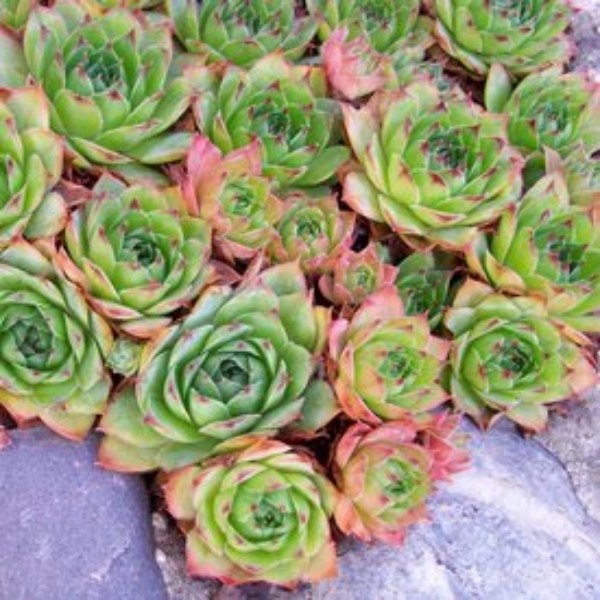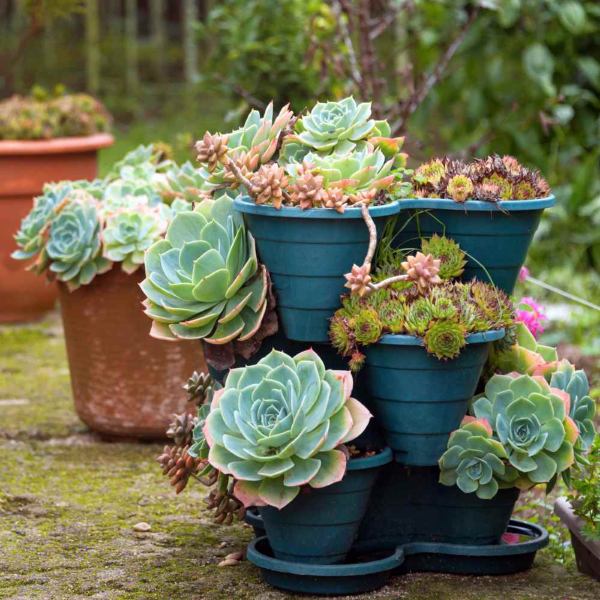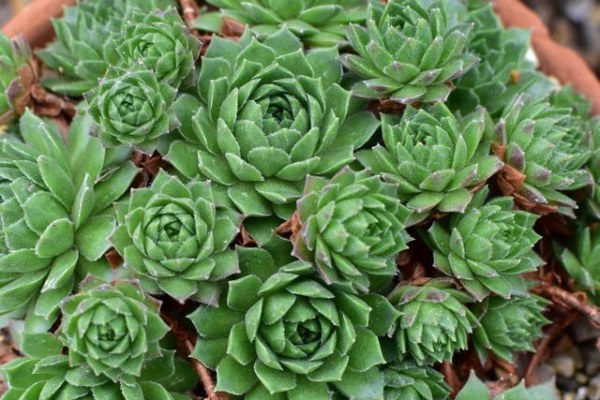Introducing the charming Hens and Chicks Plants! These houseplants have fleshy, pointy leaves in colors like green, pink, blue, grey, purple, orange, and burgundy. The main rosette, or ‘hen,’ blooms with bell-shaped flowers in the summer, then dies, leaving smaller ‘chicks.’ Indoor plants might not bloom much, but outdoor ones can show off yellow, coral, pink, or orange flowers. The rosettes grow 1 to 4 inches tall and 2 to 12 inches wide and produce offsets, which increase to 14-24 inches tall and spread out 24 to 36 inches wide.
Below this article has everything you need to learn about these beautiful plants.
Plant Description
Plant Type: Perennial
Botanical name: Sempervivum spp.
Genus: Sempervivum
Common Name: Hens and Chicks
Season: Summer Bloom, Winter Interest
Toxicity: Non-toxic
Varieties of Hens and Chicks Plant
Sunset
Sunset, scientifically known as Sempervivum tectorum, is popular for its beautiful leaves that show off contrasting colors. It grows strong, forming dense clumps as it thrives. In cool fall weather, its leaves can turn from green and burgundy to a lovely orange-red shade. Sunset also blooms with delicate pink flowers, adding to its charm. This plant is typically grown about 1 to 3 inches tall by 4 to 6 inches wide.
Purple Haze (Job’s Beard)
Purple Haze is native to the Carpathian Mountains in Europe. It has large rosettes with creamy edges on their leaves. They grow to about 3 inches tall and spread 5 to 6 inches wide. They keep their colors vibrant all year, from mauve and green leaves to yellow flowers. Purple Haze plants are tough, enduring cold, rain, heat, and drought well.

‘Greenii’ houseleek
Grennii is originally from the southern Alps. Its large rosettes and distinctive pattern make it a standout in gardens. It grows 4 to 6 inches tall and spreads 4 inches wide, forming colonies that are 9 to 12 inches across. The plant has blue-green leaves with brownish tips. It quickly spreads into tight clumps of rosettes that produce attractive pink star-shaped flowers.
Cebenese
Cebenese, scientifically named Sempervivum arachnoideum, has white fibrous strands that look like cobwebs on its leaves. These strands help the plant retain water. It grows up to 3 inches tall and spreads 4 inches wide, forming colonies up to 12 inches across. Cebenese has pale green leaves with mauve edges, adorned with white webbing, and blooms with pink flowers.
Care and Maintenance Tips for Hens and Chicks Plants
Lights: Hens and Chick plants thrive in full sun, requiring at least 6 hours daily. They will tolerate some shade, especially in hot climates, but too much will fade colors and weaken their growth.
Soil Requirements: Hens and Chick plants prefer lean, sandy soil with good drainage. This plant grows best in soil that’s neutral, with a pH between 6.5 and 7.5. If your soil is heavy, you can also add gravel, sand, pumice, or perlite to help with drainage.
Watering Guidelines: Even though Hens and Chicks can handle drought, they still need watering every week, especially in dry and warm weather. Let the soil dry out completely between waterings. Avoid excessive watering.
Temperature and Humidity: Hens and chicks grow well within the temperature ranges of 65°F to 75°F. If the weather is too cold, they grow very slowly and almost become semi-dormant. They can thrive in conditions with low to modest humidity but will also do quite well in indoor containers within high-humidity locations to prevent promoting rot and fungal issues.
Fertilizing Tips: Hens and chicks do not require much fertilizer. If you want, apply a slow-release granular fertilizer in the spring. For outdoor pots, feed a balanced liquid fertilizer at 1/4 strength every week or two in spring and summer. However, stop fertilizing in fall and winter.

Pruning Instructions: Remove any brown, yellow, or damaged leaves when necessary, although this plant doesn’t need pruning. When the hen blooms, it will naturally fall over, but you can trim the flowering stem if you want to.
Pests and Diseases Management: Indoor hens and chicks might get pests like mealybugs or aphids. Use organic insecticidal soap or neem oil to treat these pests and diseases. Good airflow can also stop fungal diseases from growing
Propagation method of Hens and Chicks plant
You can propagate hens and chicks in two main ways. First, divide them by separating smaller offsets called “chicks” from the main plant. Cut the root connecting them and replant the chick elsewhere.
Second, you can also propagate them from seeds in spring or fall. Use gritty soil like cactus mix in trays or pots, sprinkle seeds on top, and keep soil moist until seeds sprout (up to 5 weeks). Protect seedlings with gravel, then transplant outdoors once they’re about 1 inch wide and used to light and temperature. You can also scatter seeds in a sunny rock garden or another suitable spot.
Growing hens and chicks in Gardens and Pots
-
Planting in Gardens
There are many ways you could plant hens and chicks in your garden. These hardy succulents make wonderful groundcover at the front of a water-saving border, planted in a narrow strip beside the curb, or used in a rock garden. You might mass them on a slope to get a close look at the rosettes or let them spill over a rock wall.
Planting Hens and Chicks requires just a small hole for the roots. Take the plant and place it into the hole, then spread out the roots. Fill with soil up to the base of the plant and press down with your fingers gently. Take care not to go too deep. Water lightly and regularly until the plant establishes itself. Consider adding a thin layer of gravel around the base to prevent rot.

-
Container Gardening Tips
Basically, you can plant hens and chicks in pots or containers. These plants have shallow roots, so it is easily grown in small pots and shallow bowls. Always use pots with drainage holes at the bottom for good drainage. Use a special soil mix made for succulents and cacti. When you water, make sure to water thoroughly until water drains from the bottom of the pot.
Also read, Low maintenance Garden border Ideas || Best plants for garden edges
Frequently Asked Questions
1. What are Hens and Chicks Plants?
Hens and Chicks, also known as Sempervivum, are a genus of succulent plants with leaves that grow in a rosette shape. They will often form clusters or offsets around a central ‘hen’ plant.
2. Can Hens and Chick plants tolerate full sun or shade?
Hens and Chick plants thrive in full sun, requiring at least 6 hours daily. They will tolerate some shade, especially in hot climates, but too much will fade colors and weaken their growth.
3. Are Hens and Chick plants toxic to pets or children?
No, Hens and Chicks plants are not toxic to pets or children.
